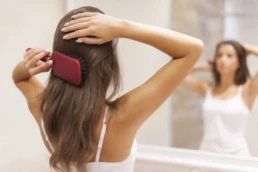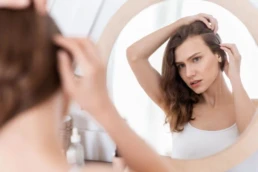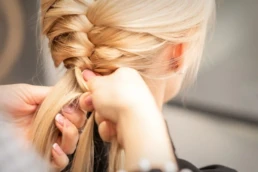Looking for a way to achieve healthier, shinier hair while cutting down on frequent washes? Enter the concept of hair training—a buzzworthy trend that promises to balance your scalp’s natural oils and reduce greasiness over time. With the right approach and high-quality products, hair training can help you simplify your hair care routine and achieve long-lasting results.
This guide will break down the science behind hair training, how to do it effectively, and the best practices for maintaining your hair’s health during the process. Whether you’re tired of daily washes or looking to minimize product usage, hair training could be the solution you’ve been searching for.
What is Hair Training?
Hair training is the process of reducing the frequency of hair washes to adjust your scalp’s oil production. While results vary, some individuals report less greasiness over time by using techniques like dry shampoo, sulfate-free products, and gradually extending washing intervals. Patience and consistency are key to seeing changes.
This practice has gained popularity due to its potential benefits, including healthier hair and a reduced reliance on shampoo. By decreasing the frequency of washes, proponents suggest you allow your scalp to reach a natural balance of oil production.

The Science Behind Hair and Oil Production
Our scalps produce a natural oil called sebum, essential for keeping hair moisturised and healthy. Sebum protects the hair shaft and scalp from drying out, but excessive oil production can result in greasy hair. Proponents of hair training believe that by washing hair less frequently, the scalp will adjust and produce less sebum over time.
However, scientific evidence on hair training is mixed. Some experts suggest that sebum production is largely determined by genetics and hormones, making it difficult to alter through changes in washing habits. Others argue that frequent washing with harsh products can overstimulate oil production, and using gentler products while reducing washes allows the scalp to recalibrate.
Regardless of the debate, many individuals find success with hair training when paired with high-quality products that support their goals. For instance, Aveda’s Scalp Solutions Line™ or Evo’s Water Killer Dry Shampoo can help reduce reliance on frequent washes while maintaining a fresh, balanced scalp.
How to Train Your Hair to Be Less Oily
Tired of battling oily hair? Training your scalp to produce less oil may be the game-changer you need. Here’s a step-by-step guide to help you get started, featuring Aveda and Evo products for optimal results:
- Gradually Extend Your Washing Schedule: Start by increasing the time between washes. If you currently wash daily, switch to every other day for a few weeks, then extend it to every three days. Gradual changes help your scalp adjust to a new routine. Aveda’s gentle shampoos are perfect for maintaining balance during this transition.
- Use Dry Shampoo: Dry shampoo absorbs excess oil, keeping your hair looking fresh between washes. Evo’s Water Killer Dry Shampoo is a salon-favourite for its dual-action cleansing and styling benefits.
- Opt for Sulfate-Free Products: Sulfates can strip natural oils, potentially leading to increased oil production. Aveda’s sulfate-free shampoos and conditioners nourish your hair while maintaining its natural balance.
- Brush Regularly: Brushing your hair distributes oils from the scalp down the hair shaft, reducing greasiness at the roots and keeping your hair nourished. Use a high-quality brush to avoid damaging your hair.
- Avoid Touching Your Hair: Frequent touching or brushing can stimulate the scalp and increase oil production. Try to minimize unnecessary contact with your hair.
- Be Patient and Consistent: Results take time. Stick to your new routine and monitor your hair’s response over weeks and months.

How Long Does It Take to Train Your Hair?
The time required to see results varies widely. Some people notice changes within a few weeks, while others may take several months. Factors like hair type, lifestyle, and environmental conditions all play a role. Working with salon-quality products from Aveda and Evo can help you navigate this journey more effectively.
Common Misconceptions About Hair Training
Hair Training is a Myth
While it may not work for everyone, many people report success. Results depend on individual factors like hair type and lifestyle. Hair training requires realistic expectations and a willingness to experiment.
Washing Less Will Ruin Your Hair
Proper care, including regular brushing and using dry shampoo, can keep your hair healthy even with less frequent washing. In fact, over-washing with harsh products can strip hair of essential oils, leading to dryness and hair damage.
Your Hair Will Smell Bad
Good hygiene practices and dry shampoo can keep your hair smelling fresh during the training process. Evo’s dry shampoo offers a light, pleasant fragrance that refreshes hair between washes.
Everyone Can Train Their Hair
While many people see benefits, factors like scalp conditions, hair texture, and hormonal influences can affect the outcome. Not everyone will achieve the same results.
Advanced Tips for Hair Training Success
- Incorporate Scalp Massages: Massaging your scalp stimulates circulation and can help distribute natural oils evenly. It also promotes relaxation, which may reduce stress and support overall hair health.
- Experiment with Hairstyles: On days when your hair feels oily, opt for styles like braids, buns, or ponytails to mask greasiness.
- Monitor Environmental Factors: Humidity, exercise, and air pollution can affect how oily your hair feels. Adjust your routine and product use as needed.

FAQs About Hair Training
How long does it take to train your hair?
It varies. Some people notice changes within a few weeks, while others may take several months. Consistency and the right products are key.
Can hair training damage my hair?
No, as long as you maintain proper scalp hygiene and use quality products like those from Aveda and Evo, hair training is safe.
Can you suggest hairstyles to manage oily hair?
When dealing with oily hair, styles like sleek ponytails, braids, or messy buns can be perfect. These looks not only conceal greasiness but also make use of your hair’s natural texture for a polished finish.

Final Thoughts on Hair Training
Hair training offers an opportunity to reassess your hair care routine and prioritise its long-term health. By incorporating high-quality products like Aveda and Evo into your regimen, you can support your scalp’s natural balance while exploring this popular trend.
At Charm and Champagne Beauty Studio, our stylists can recommend the best products and techniques to suit your unique hair type. Book an appointment today to start your journey to healthier, more manageable hair!

